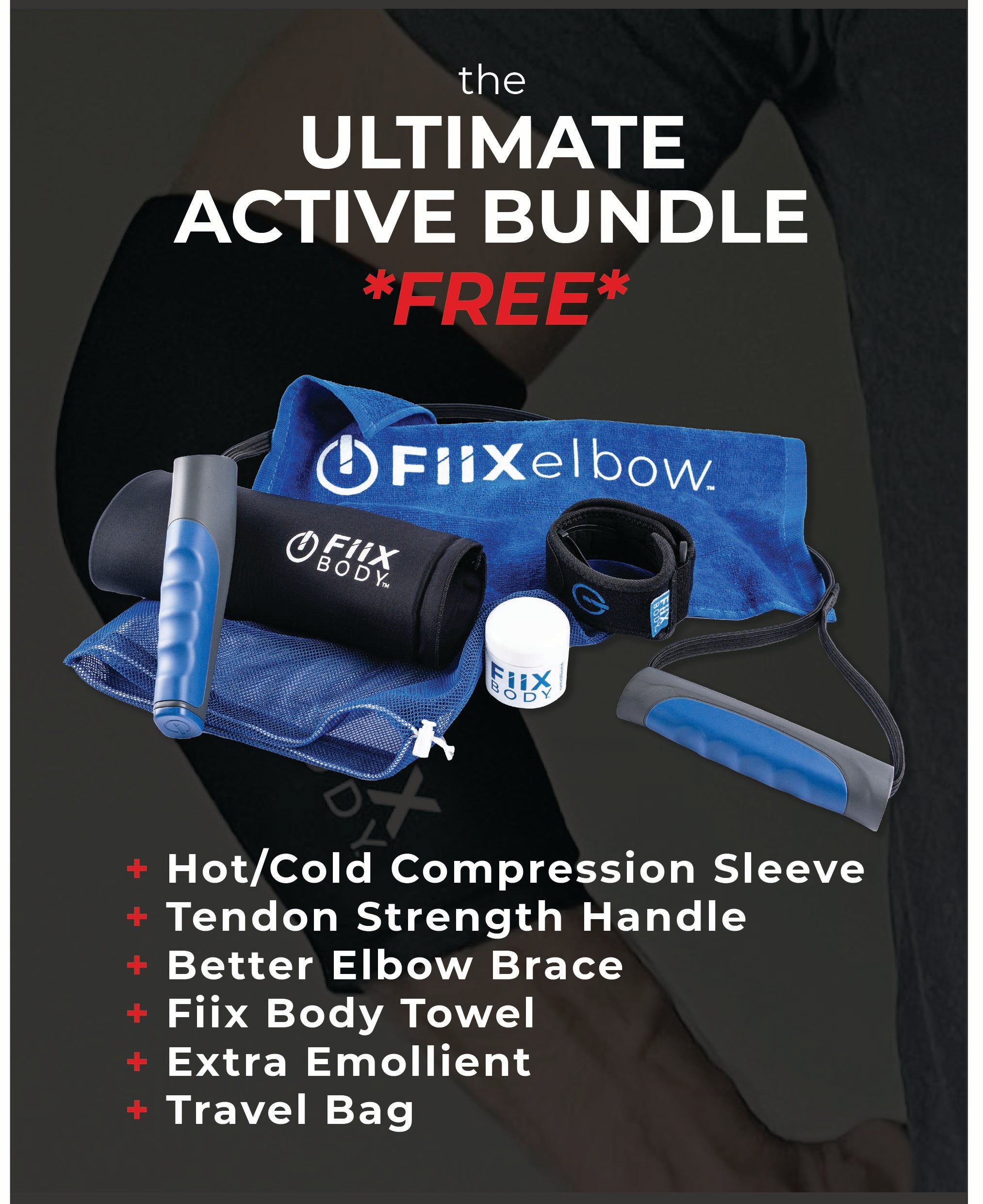If you suffer from tennis elbow and you’d like to know what the best tennis elbow treatment is, you’re not alone. Approximately 6.5 to 9.5 million people in the United States suffer from this painful condition. And the name adds confusion to the injury because less than five percent of people actually get it from playing a racquet sport.
In fact, anyone who uses their arms to perform repetitive movements is susceptible, which significantly broadens the potential patient population. This includes golfers, fitness enthusiasts, musicians, gamers, crafters, construction and manufacturing workers, plumbers, hairdressers, cooks and butchers. Office workers who type and work on computers all day also are prone to tennis elbow.
Over time, repetitive motions can cause microscopic tears in the tendons that connect the forearm muscles to the outside of the elbow. This leads to pain and inflammation, particularly when gripping items, shaking hands, brushing your teeth or turning a doorknob. Pain can worsen over time and typically does not go away on its own. Although a variety of treatment options exist, they are not equally effective in healing this injury.
Tennis elbow treatment at home
The most common first-line treatments are rest and over-the-counter pain relievers, such as aspirin, ibuprofen, acetaminophen and naproxen. If tennis elbow is caused by a job, however, rest isn’t usually a practical option unless adequate time can be taken to eliminate the repetitive motions and stimulate healing. Unfortunately, however, the discomfort still may recur upon resumption of work.
As for pain relievers, they can temporarily mask the pain, but it returns. And long-term usage of NSAIDS is not recommended as a solution.
Other options for tennis elbow treatment at home include ice to decrease inflammation, which can relieve pain in the moment. Heat therapy can be used to promote blood flow and relax the muscles.
A variety of braces, compression sleeves and straps serve to reduce movement at the elbow and take the strain off the tendons and muscles for short-term relief. Cyrosleeves also incorporate cold therapy to reduce inflammation.
Professional tennis elbow treatments
Tennis elbow sufferers can opt for a variety of treatments available from healthcare professionals, such as physical therapists, chiropractors, physicians and surgeons, as well. These include:- TENS. These devices deliver mild electrical impulses through the skin to the nerves to block pain signals from reaching the brain. Some units can be purchased for home use, but professional treatment offers more customization and range of power. Note that this treatment is not specific to tennis elbow, and is used for a variety of conditions.
- Ultrasound. High frequency sound waves are applied to warm the injured area and cause expansion and contraction in the tiny gas bubbles of the soft tissues. This can help decrease inflammation and pain. Again, while home units are available, they used pulsed ultrasonic ways, while professional units deliver continuous waves. And like TENS, ultrasound isn’t specific to tennis elbow only.
- Acupuncture. Inserting needles into specific areas of the body may relieve pain by releasing endorphins, the body's natural pain-killing hormones.
- Injections. Inflammation can be reduced through injections of steroids, such as cortisone. A cortisone shot prevents production of collagen in the tendon, which suppresses inflammation and calms nerves to reduce pain; however, these tend to be more effective in the shoulders and the hips. Another option is platelet-rich plasma (PRP), which is developed from the patient’s own blood and platelets to accelerate tendon healing. PRP injections, however, are expensive and typically not covered by insurance; and more than one shot may be required over time.
- Surgery. Note that surgery is rare; it is only required for approximately five percent of tennis elbow cases. It involves detaching parts of the forearm muscles. Recovery and rehabilitation take several months.
- Physical Therapy. Physical therapists use a combination of stretching and strengthening exercises, localized manual therapy, TENS, ultrasound and ice to address tennis elbow. Exercises help strengthen the muscles in the forearm and wrist to reduce strain on the tendons, and manual therapy, such as massage or instrument-assisted soft tissue mobilization (IASTM), can help improve mobility without pain. The greatest challenge with physical therapy for tennis elbow is the time-consuming regimen, consisting of two to three 60-minute appointments each week, for eight to 12 weeks. Adherence is critical for success, and people have difficulty complying.
The best tennis elbow treatment
It’s clear that both home and professional tennis elbow treatments have various drawbacks, and each can take several months. When it comes to this nagging condition, people are seeking to permanently eliminate the pain and resume their activities.
The good news is that a new treatment option now exists. The Fiix Elbow program from Stā Active combines the effectiveness of professional therapy with the convenience of home self-care. Until the Fiix Elbow program, no proven products have existed for chronic tennis elbow sufferers to use at home to recover.
The Fiix Elbow program automates the research-backed and clinically proven IASTM therapy by delivering concentrated, repetitive linear strokes to the tendons. Typically performed by physical therapists, IASTM applies controlled microtrauma to the tendons to break down adhesions and scar tissue and stimulate a local inflammatory response. This remodels the tissue through cellular and tissue regeneration and collagen production to ultimately provide pain relief and promote functional restoration.
The Fiix Elbow program regimen is 10 minutes per day, three times per week for eight weeks, along with strength and stretching exercises to boost circulation, stimulate collagen cross-linkage formation, improve mobility and decrease risk of future injury.
In initial trials of the Fiix Elbow program, 96 percent of subjects reported a significant reduction in pain, and, on average, subjects showed a greater than 76 percent improvement in functional activities, and a 85 percent average increase in grip strength.
Even more, the Fiix Elbow program saves tennis elbow sufferers time and money, with no need to deal with scheduling hassles, clinic appointments or insurance deductibles, co-pays or paperwork. This non-invasive, drug-free treatment can be used over time as well to manage any periodic flare-ups. And with a 90-day, money-back guarantee, the Fiix Elbow program is risk-free to patients. All they have to lose is the pain!



Share:
Which is Better for Tennis Elbow, the Fiix Elbow or Percussion?
Does Dry Needling Work for Tennis Elbow?